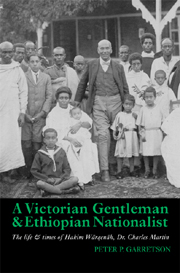 A Victorian Gentleman and Ethiopian Nationalist
A Victorian Gentleman and Ethiopian Nationalist Book contents
- Frontmatter
- Contents
- List of Illustrations
- Transliteration
- Note on the Ethiopian Calendar
- Glossary
- Acknowledgements
- Map 1 Ethiopia 1900–1950
- Map 2 Burma 1898–1919
- Introduction
- 1 Youth & education
- 2 Return to Ethiopia (1896–1901)
- 3 Campaigning in the Ogaden & return to Burma (1901–1907)
- 4 Transitions in life
- 5 A man of substance in Ethiopia & Burma
- 6 Return of a progressive to Addis Ababa (1919–1924)
- 7 An increased pace of modernization (1924–1930)
- 8 International diplomacy, education & recruitment
- 9 Governor of a model province, Chärchär (1930–1935)
- 10 Ethiopian ambassador to the Court of St. James (1935–1936)
- 11 London & India
- 12 Ethiopia
- Conclusion
- Bibliography
- Index
9 - Governor of a model province, Chärchär (1930–1935)
Published online by Cambridge University Press: 05 April 2013
- Frontmatter
- Contents
- List of Illustrations
- Transliteration
- Note on the Ethiopian Calendar
- Glossary
- Acknowledgements
- Map 1 Ethiopia 1900–1950
- Map 2 Burma 1898–1919
- Introduction
- 1 Youth & education
- 2 Return to Ethiopia (1896–1901)
- 3 Campaigning in the Ogaden & return to Burma (1901–1907)
- 4 Transitions in life
- 5 A man of substance in Ethiopia & Burma
- 6 Return of a progressive to Addis Ababa (1919–1924)
- 7 An increased pace of modernization (1924–1930)
- 8 International diplomacy, education & recruitment
- 9 Governor of a model province, Chärchär (1930–1935)
- 10 Ethiopian ambassador to the Court of St. James (1935–1936)
- 11 London & India
- 12 Ethiopia
- Conclusion
- Bibliography
- Index
Summary
When Wärqenäh was appointed as governor of Chärchär province by Emperor Haylä Sellasé, he approached his new responsibility with energy and enthusiasm, despite his sixty-five years. One of the emperor's major goals after his coronation in 1930 was to improve local administration and he began by focusing on improving the administration of a small number of ‘model provinces’, of which Chärchär was one. That Chärchär has been described as a ‘most notable example’ of a model province is due to the efforts of two successive governors: Fitawrari Täklä Hawaryat and Azaj Wärqenäh. Täklä Hawaryat had laid a foundation upon which Wärqenäh built, expanding and solidifying the previous administration's achievements. Wärqenäh's priorities for progressive change were broadly two, moral changes and basic reforms. His first task was to eliminate bribery and promote honesty and tolerance in government. The first he attacked by urging all his administrators to take an oath and the second by trying to set an example from the top to improve relations with Oromos and Muslims. He then focused on the classic reforms needed for modernization. First and most important was reforming the bureaucracy; he appointed a number of young, educated and highly qualified men to his administration. Second, he cracked down hard on slavery and the slave trade. Third, he systematically followed through on earlier reforms, expanding the road network of his province and linking them to the railroad. Fourth, he successfully expanded the reach of the province into the neighboring Adal lowlands and finally, he founded or improved schools, hospitals and clinics throughout his province.
- Type
- Chapter
- Information
- A Victorian Gentleman and Ethiopian NationalistThe Life and Times of Hakim Wärqenäh, Dr. Charles Martin, pp. 173 - 203Publisher: Boydell & BrewerPrint publication year: 2012
